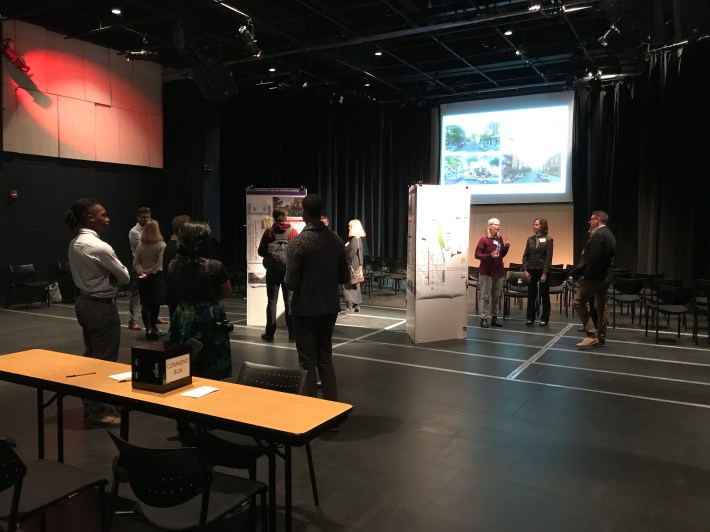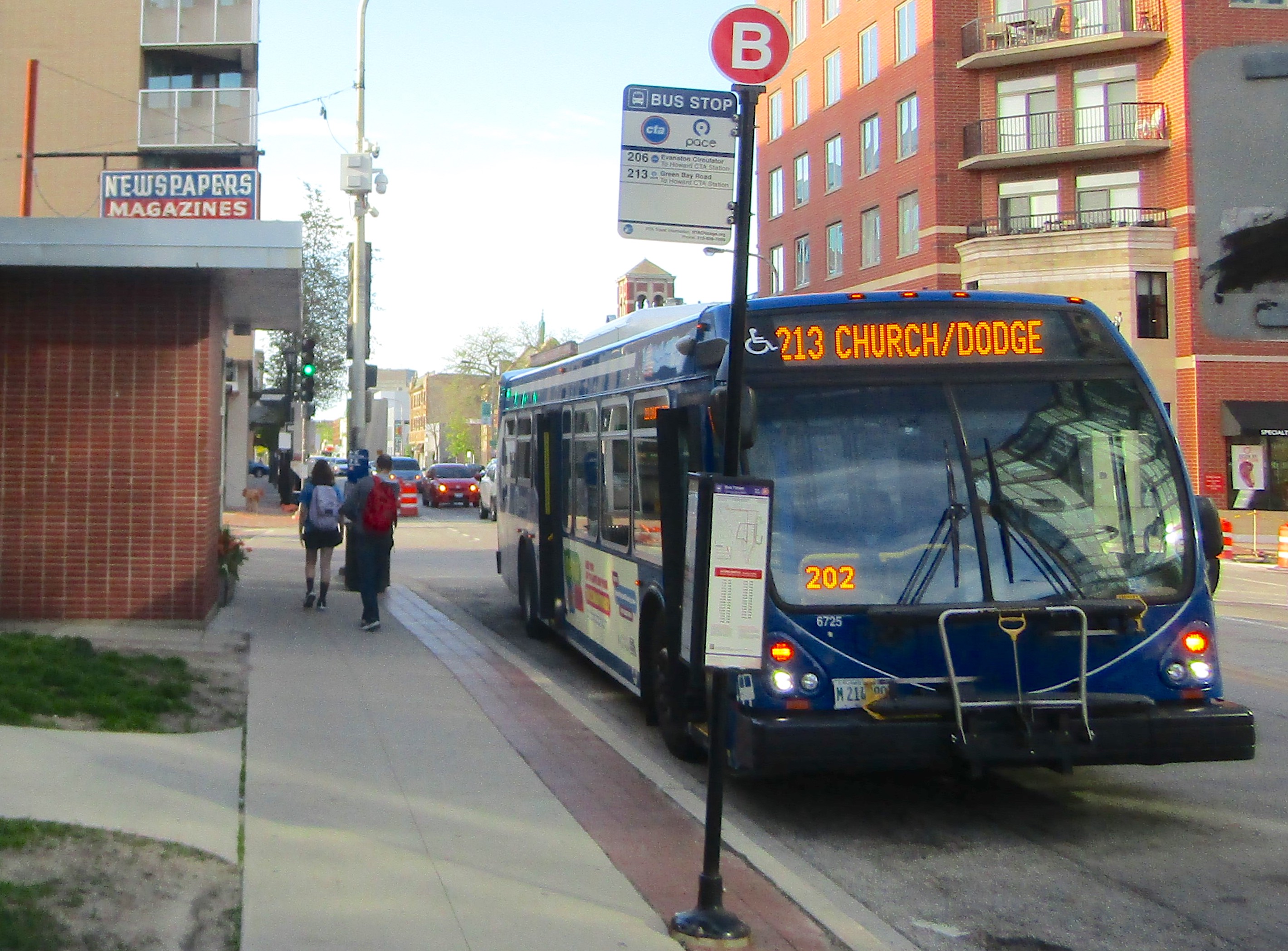The Belmont Flyover: Learning From the Past and Planning the Future
2:40 AM CDT on May 7, 2017

Renderings of a section of the flyover project area without and with redevelopment. Images: CTA
The history of U.S. transit projects has been rife with angry residents and lawsuits galore that have sometimes resulted in sub-par outcomes. The Belmont Flyover, one of the key pieces of the CTA’s Red and Purple Modernization project, has been highly controversial, largely because it will require the demolition of a number of buildings in Central Lakeview. But, thankfully, the dialogue at last Thursday’s community meeting on redeveloping the flyover project area after the structure is built was generally constructive, not acrimonious.
The first phase of RPM, including the flyover, track and signal work, and overhauls of four Red Line stations in Uptown and Edgewater, is currently scheduled to start in 2018, finishing around 2025. After the Obama administration committed to funding about half of the roughly $2 billion project in January, community members who had previously fought against the overpass said they had accepted that it was going to be built. They said they had changed their focus on and pushing for the best possible redevelopment outcome.
It’s going to be important for the city to learn the mistakes of the past, particularly the failure to promptly redevelop several lots that were left empty for five or more years after the Brown Line reconstruction was finished in 2010. The CTA is trying to stay on top of this issue by hosting a series of public meetings to collect feedback on what kind of transit-oriented development community members want to see on the land that is cleared for the flyover.
Thursday’s meeting was very open-ended, with CTA staffers asking attendees for general and specific feedback about what they want to see from the redevelopment, as well as providing useful info about existing, under construction, and proposed developments. The transit agency has limited the area under discussion to a compact zone, mostly between Cornelia (3500 North) to the north, Belmont (3200 North) to the south, Sheffield (1000 West) to the west and Clark to the east.
While the project area is small, it’s packed with businesses, almost half of them bars and restaurants. The district also boasts a 91 percent occupancy rate and 90 percent of the businesses are locally owned, positive numbers that the CTA does not want to negatively impact via its redevelopment decisions.
Residents were encouraged to leave both stickers and Post-It notes on the display boards to provide input about their wishes for the future of the area. The comments expressed a fervent desire for more of what already heavily populates the district, locally owned businesses with high-density apartments or condos on top. There was also some support voiced for more open space and other types of housing, including affordable units.

The CTA also asked for feedback on what should occupy the spaces under the ‘L’ tracks after the flyover is completed. Interestingly, most of the attendees did not support using this space for car parking. Instead, the majority favored community-oriented uses such as public and programmable spaces, public art, bike parking, and beefed-up storm water management.
The post-it notes also expressed a desire to maintain the community’s character as new retail and housing is created. Several people said they didn’t want to see more chain stores, such as Target – the big-box giant is about to open a store in a new transit-oriented development at Belmont and Clark, on the former Punkin’ Donuts site.
A few comments also called for taller buildings, but were critical of massive superblock developments and said that any off-street parking should be hidden from view. And almost every display board every poster had Post-Its calling for historic preservation and for new developments to adhere to local architecture styles.
The specter of the missteps from the Brown Line reconstruction hung over the meeting and people did not hesitate to express their grievances with what was finally built. There were many comments left on a board on the subject of “building character” that stated a distaste for flat, modern glass-and-steel structures and a preference for vintage-style brick architecture with tasteful accents bringing life to what otherwise be a boring building. One Post-It went so far as to say one glass-and-steel example on the display board had no place in Chicago and was better suited for a city like less architecturally distinguished city Dallas instead.
Many people asked if the historic façades of buildings slated for the wrecking ball could be saved and integrated into the new developments and requested that the CTA study this issue. A CTA representative told me the agency has a full historic preservation team working on these issues.

Residents I spoke to at the meeting had some interesting perspectives on the project. Ellen Hughes, who spearheaded the efforts to stop the flyover project but recently said she has come to terms with the project’s inevitability, said she is now very interested in making sure the project proceeds as something that can benefit the entire community. Hughes said she’s particularly concerned about Clark Street, maintaining its character, given its unique and varied architecture, and she wants “cookie-cutter” designs to be rejected.
Phil Darling said he currently feels fairly positive about the flyover project, specifically the straightening of the existing kink in the train tracks the Belmont station and Newport Avenue, which will help speed train service. but still skeptical about the flyover wishing the CTA do a better job selling the project. Like Hughes, he said he’s adamant about new development maintaining the “Chicago look” of Clark Street, while bringing the neighborhood in the future.
Jacob Peters gave a full-throated endorsement of the flyover he considers it to be entirely necessary for increasing capacity on the Red Line and reducing rush-hour crowding. Unlike many commenters, he said he supports a mix of modern and classic, but added that it’s important to make sure new buildings compliment the style of existing architecture, including issues of height and density.
On the subject of affordable housing, he said any transit-oriented developments that require upzoning should be required to adhere to local affordable housing requirements, while “as-of-right” developments (those not needing a zoning change) should continue to be exempt. Peters said he also wants more info from the CTA on how they plan to avoid leaving lots undeveloped for several years, as was the case after the Brown Line reconstruction.
CTA spokesman Jeff Tolman said the flyover redevelopment plan is still very much in the concept phase and emphasized the importance of community input for crafting the final plan. Mr. Tolman implied that this feedback, while currently only being used for properties impacted by the project, could easily be transformed into a guide for future zoning changes. He encouraged Chicagoans who are interested in weighing in on the development to do so on the RPM project website.
Stay in touch
Sign up for our free newsletter
More from Streetsblog Chicago
Since COVID, Pace ridership has fared better on major corridors and in north, northwest suburbs than in south, west ‘burbs
The suburban bus system's top five busiest routes largely maintained their ridership rankings.
Due to incredible support from readers like you, we’ve surpassed our 2023-24 fundraising goal
Once again, the generosity of walk/bike/transit boosters is fueling our reporting and advocacy.



